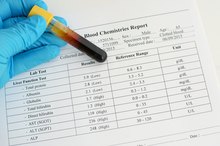How Is Osmosis Used in Kidney Dialysis?
Kidney Function
Kidney dialysis is used to replace normal kidney function when the kidneys have become damaged and no longer function properly. The kidneys help control the levels of certain dissolved minerals called electrolytes as well as help filter out waste products (metabolites) that are created by cells using energy. This helps the body maintain stable amounts of compounds such as sodium, potassium and calcium in the blood as well as remove potentially toxic compounds. These toxic compounds are filtered out of the blood and then concentrated by the kidneys into urine, which allows them to be excreted fromt he body. When the kidneys fail, dialysis can be used to take over that function.
If you are experiencing serious medical symptoms, seek emergency treatment immediately.
- Kidney dialysis is used to replace normal kidney function when the kidneys have become damaged and no longer function properly.
- The kidneys help control the levels of certain dissolved minerals called electrolytes as well as help filter out waste products (metabolites) that are created by cells using energy.
Osmosis
What Is the Most Abundant Electrolyte Found in Blood Plasma?
Learn More
Osmosis is a chemical process by which dissolved chemicals will migrate from an area of high concentration to one of low concentration. Essentially if you dissolve something in a liquid, the dissolved compounds (called solutes) will spread out until there is an equal concentration of solute everywhere. Sometimes osmosis works by movement of the solutes until concentration is even everywhere throughout the liquid. However, sometimes osmosis works by having more of the dissolving liquid (called the solvent) move to an area of concentrated solute (to dilute the solute), because this also equalizes the concentration of dissolved solutes.
- Osmosis is a chemical process by which dissolved chemicals will migrate from an area of high concentration to one of low concentration.
- However, sometimes osmosis works by having more of the dissolving liquid (called the solvent) move to an area of concentrated solute (to dilute the solute), because this also equalizes the concentration of dissolved solutes.
Osmosis and Dialysis
Kidney dialysis machines use osmosis to take over the filtering function of the kidneys 1. Dialysis machines use a semi-permeable membrane, which is a membrane through which some small molecules can pass (such as water, salts, and metabolites) but through which larger objects (such as proteins and blood cells) cannot 1. Dialysis machines take the blood and place a semi-permeable membrane between the blood and a large volume of a liquid called the dialysis solution 1. Osmosis causes the metabolites to flow out of the blood, through the membrane, and into the dialysis solution, which is continuously replaced. The membrane also allows electrolytes to pass through so that the blood can get rid of extra electrolytes. Consequently, dialysis machines use the power of osmosis to get toxins out of the blood and replace the filtering function of the kidneys 1.
Related Articles
References
- KidneyAtlas.org: Dialysis Machines
- Banshodani M, Kawanishi H, Moriishi M, Shintaku S, Tsuchiya S. Association between dialysis modality and cardiovascular diseases: A comparison between peritoneal dialysis and hemodialysis. Blood Purif. 2019;:1-8. doi:10.1159/000504040
- Ch'ng CC, Ong LM, Beh KKM, et al. Survival advantage of initiating dialysis in elderly and non-elderly incident end stage kidney disease patients. Nephrology (Carlton). 2020; Jan 4. doi:10.1111/nep.13689
- Hussain JA, Flemming K, Murtagh FE, Johnson MJ. Patient and health care professional decision-making to commence and withdraw from renal dialysis: a systematic review of qualitative research. Clin J Am Soc Nephrol. 2015;10(7):1201-15. doi:10.2215/CJN.11091114
- US Renal Data Systems. Bethesda MD: National Institutes of Health, National Institute of Diabetes and Digestive and Kidney Diseases; 2019. Chapter 5, Mortality. USRDS 2019 Annual Data Report.
Writer Bio
Adam Cloe has been published in various scientific journals, including the "Journal of Biochemistry." He is currently a pathology resident at the University of Chicago. Cloe holds a Bachelor of Arts in biochemistry from Boston University, a M.D. from the University of Chicago and a Ph.D. in pathology from the University of Chicago.







